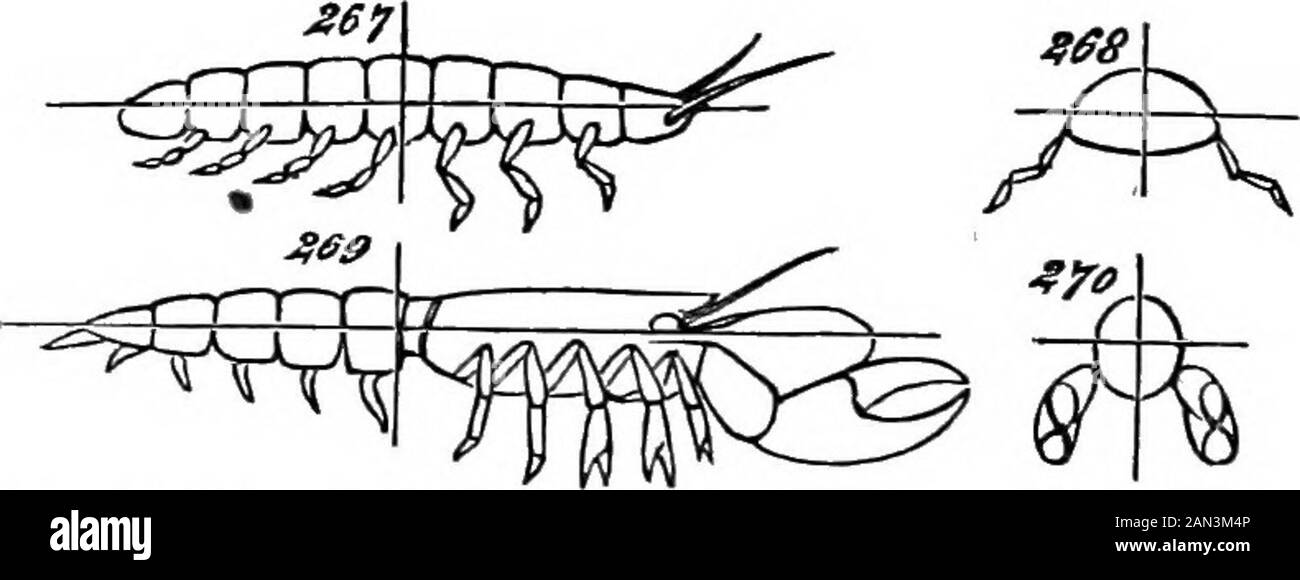The principles of biology . ot strongly marked. The form deviates but little fromwhat we have distinguished as triple bilateral symmetry: ifthe creature is cut across the middle, the head and tail endsare very much alike; if cut in two along its axis by a hori-zontal plane, the under and upper halves are very muchalike ; and if cut in two along its axis by a vertical plane,the two sides are quite aKke. Figs. 263 and 264 will makethis clear. Such creatures as the Julm and the Centipede, may be taken as showing a transition to doublebilateral symmetry. Besides being divisible into exactlysimilar

Image details
Contributor:
The Reading Room / Alamy Stock PhotoImage ID:
2AN3M4PFile size:
7.2 MB (186.6 KB Compressed download)Releases:
Model - no | Property - noDo I need a release?Dimensions:
2574 x 971 px | 21.8 x 8.2 cm | 8.6 x 3.2 inches | 300dpiMore information:
This image is a public domain image, which means either that copyright has expired in the image or the copyright holder has waived their copyright. Alamy charges you a fee for access to the high resolution copy of the image.
This image could have imperfections as it’s either historical or reportage.
The principles of biology . ot strongly marked. The form deviates but little fromwhat we have distinguished as triple bilateral symmetry: ifthe creature is cut across the middle, the head and tail endsare very much alike; if cut in two along its axis by a hori-zontal plane, the under and upper halves are very muchalike ; and if cut in two along its axis by a vertical plane, the two sides are quite aKke. Figs. 263 and 264 will makethis clear. Such creatures as the Julm and the Centipede, may be taken as showing a transition to doublebilateral symmetry. Besides being divisible into exactlysimilar halves by a vertical plane passing through the axis, one of these animals may be bisected transversely iato partsthat differ only slightly; but if cut in two by a horizontalplane passing through the axis, the under and upper halvesare decidedly unlike. Figs. 265, 266, exhibit thesetraits. Among the isopodous crustaceans, the departure from these low types of symmetry is more marked. As 3e3 -^9JXXDXO0CCC33JJXiXrO0CO[XXXnXJJ^. shown in Figs. 267 and 268, the contrast between the upperand under parts is greater, and the head and tail ends differ THE GENERAL SHAPES OF ANIMALS. 183 more obviously. In aU tlie higlier Articulata, the unlikeness between tbe front half and the hind half hasbecome conspicuous: there is in them single bilateralsymmetry of so pronounced a kind, that no other resem-blance is suggested than that between the two sides. ByFigs. 269 and 270, representing a decapodous crustaceandivided longitudinally and transversely, this truth is madem.anifest. On calling to mind the habits of the creatures here drawn and described, it will be seen thatthey explain these forms. The incidence of forces is thesame aU around the Earth-worm as it burrows through thecompact ground. The Centipede, creeping amid loose soil ordebris or beneath stones, insinuates itseK between solid sur-faces—the interstices being mostly greater in one dimensionthan in others. And all the higher Annu